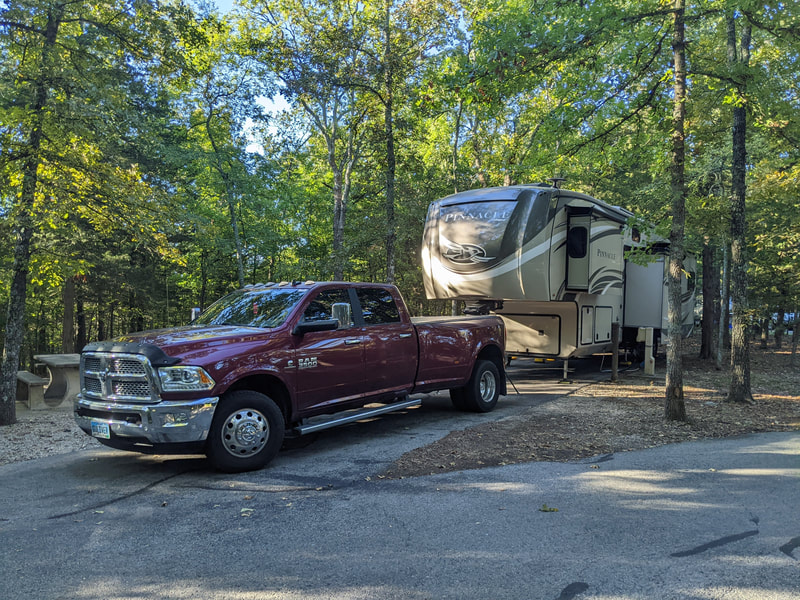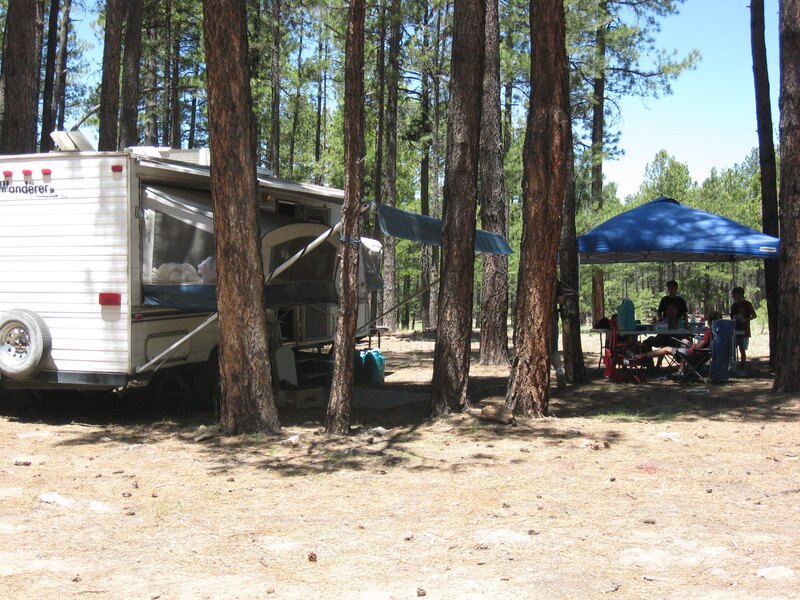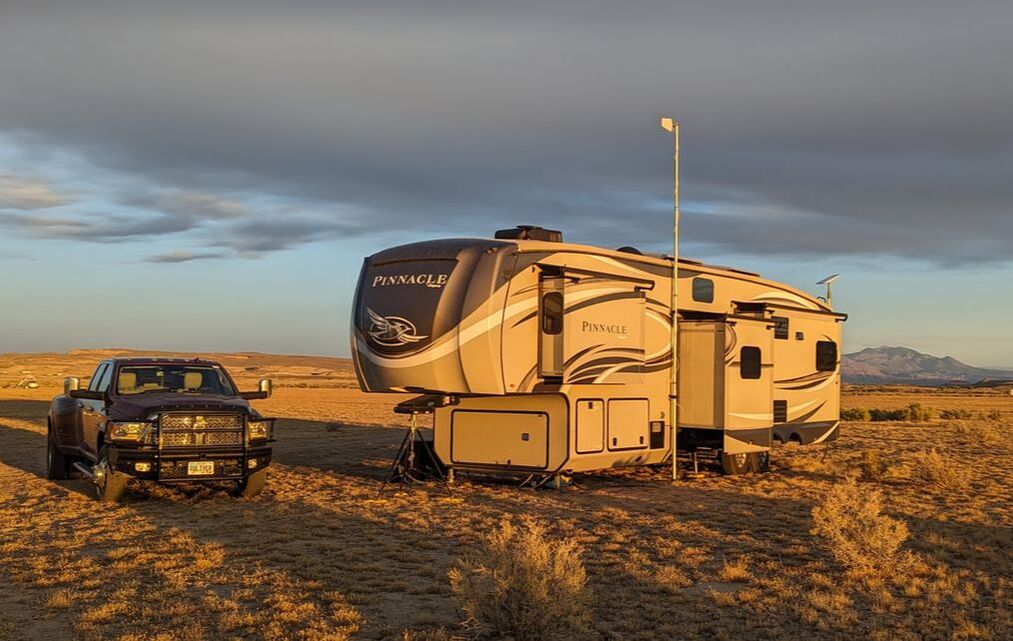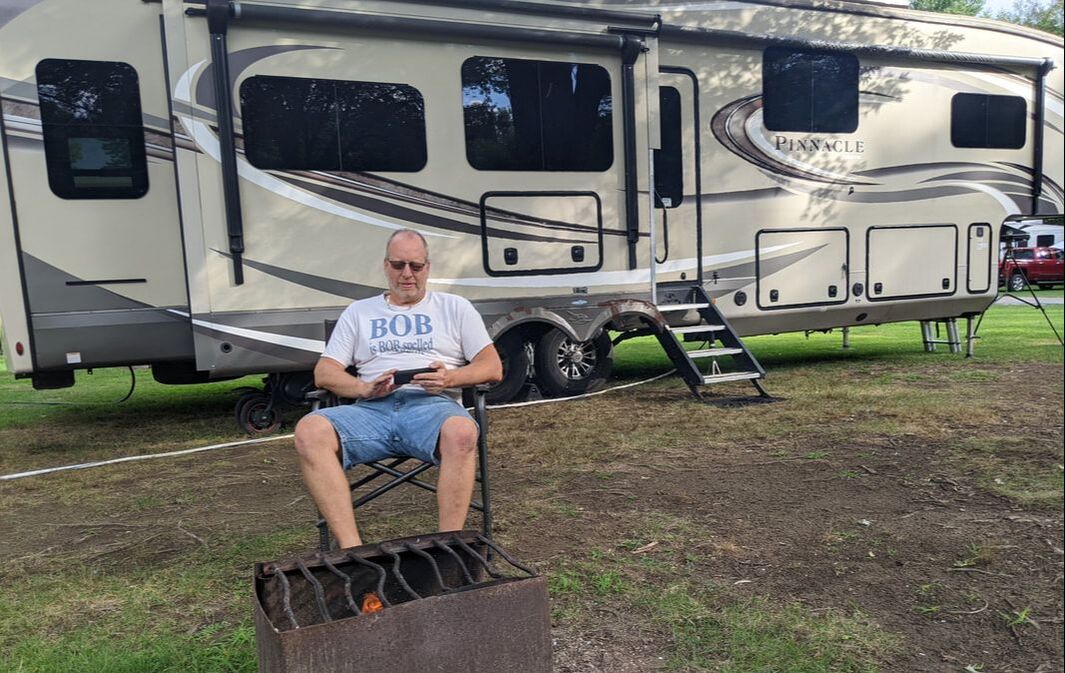|
As full-time RVers, we often get asked, “What do you want to do while you’re here?” by friends and family. Because of our RV lifestyle, many think we’re always on vacation. As intriguing and attractive as that sounds, the reality is that I work full time. That means that, although Bob isn’t employed, work responsibilities have to come first.
Back in the day, when we owned sticks and bricks and a travel trailer, we made a point to get away every summer for a family vacation, often with our trailer in tow. We enjoyed cooking and eating meals outdoors, sitting around campfires, roasting marshmallows, playing games, and exploring nature. Since we sold our sticks and bricks and moved into our fifth wheel, vacation looks a bit different. We get away to somewhere new every week or two as part of everyday RV living. We sightsee and get out in nature regularly. No longer do we plan weeklong adventures in our rig. Every day is an adventure. I used to feel guilty for sitting in our rig watching TV while other campers gathered around fires to enjoy the great outdoors, but I’m over it. Our RV life may look the same on the surface as that of weekend warriors or RV vacationers, but it’s actually quite different. Clearing Up Vacation Misconceptions An RV vacation can be a wonderful experience: a nice camping setup, maybe with family or friends, outdoor activities, and plenty of recreation. It can include stories around the campfire every night, stargazing, and sleeping in. Because we live full time in our rig, we don’t often have campfires, just as most people in sticks and bricks don’t have campfires most nights. Visiting friends and family across the country may be part of vacation for many people, but for us, it’s typically not. Sleeping in is a weekend luxury not afforded on workdays during the week — at least not for me. Our daily RV life includes sightseeing and adventures to capture the essence of the area in which we find ourselves. We try to fit in as much as we can, but we have to do that strategically around my work schedule. What Vacation Looks Like for Full-Time RVers At this point, you may be wondering “What do full-time RVers do for vacation?” More often than not, vacation for us means escaping our rig and not sleeping in our own bed. It involves taking time off work for me but may include light volunteer work for Bob. It means more eating out and less cooking in, flying not driving, fewer responsibilities and more relaxation, and investing more time and money into sightseeing and adventures than we normally would. Although our vacations often leave Tagalong behind, they may include Gulliver, like on our anniversary trip to Mexico or our visit to the Arctic Ocean. Driving the Alaska Highway was a vacation for us in that I took time off work, but it included Tagalong and sleeping in our bed every night. Our favorite kind of vacation is cruising. It gets us completely away from our rig and out on the open seas to explore areas we can’t take our rig. I relish the disconnection from my normal busy life and appreciate home more when we return. Although as full-time RVers we don’t use our rig for vacations, we continue to enjoy our RV lifestyle and the many perks that come with it. You might also like Where We Park Our Rig for Flight/Cruise Travel.
1 Comment
Despite the logistics involved in full-time RV living, the lifestyle offers numerous perks. We have the best of two worlds: months of living on the road and months in a single location. After four years of this lifestyle, we have a pretty good grasp of the perks of full-time RV living — at least for us. Others might disagree or see other things as perks, but here are our top four:
1. Freedom Because we sold our sticks-and-bricks home and live only in our 42-foot fifth wheel RV we named Tagalong, we have a lot of freedom. If we don't like our surroundings or views in one area, we can pack up and move to another without too much trouble. If we like where we find ourselves, as we did in Homer, Alaska, we can cancel our plans and choose to stay longer. The world is our oyster. 2. Seeing Family and Friends One of the greatest joys of our RV lifestyle is the ability to see family and friends across the country much more often than we'd see them otherwise. Because of our involvement with the Commemorative Air Force, our history with the Continental Singers and Orchestra, our cruise experiences, and our hailing from different geographic areas (Massachusetts for Bob and Arizona for me), we know people from the West Coast to the East Coast, and even into Canada. This can make for some great moochdocking opportunities for us, depending on our loved ones’ living situations. (Thank you, friends and family!) We truly value the times we get to spend with loved ones near and far and are thankful for the many opportunities our full-time RV lifestyle affords us to do so. 3. Amazing Scenery From magnificent rock formations to welcoming waters and everything in between, full-time RV living puts us up close and personal to beautiful scenery. For example, we camped on the top of a bluff in Wyoming, overlooking the town of Rock Springs below. We backed up our rig to Port Valdez, a fjord of Prince William Sound in Valdez, Alaska, parked with fantastic views of Lake Michigan in the Upper Peninsula of the state, camped amid red maple leaves in Idaho in the fall, stayed on spacious farms in Florida and Michigan, and saw the northern lights on our return trip from Alaska. We also glimpsed lots of beautiful sunrises and sunsets across the country. 4. Always a New Adventure And that brings us to our fourth perk of full-time RV living: It's never boring. There's always a new adventure awaiting, whether that entails investigative troubleshooting to find the cause of a leak or tracking dinosaurs in the desert of Moab, Utah. We have very few, if any, dull moments. Full-time RV living is not for everyone, but it is for us. We plan to keep enjoying it and all that it has to offer until we get sick of it or we’re physically unable to continue, whichever comes first. You might also like Is RV Life as Glamorous as It Looks? Some full-time RVers are drawn to the lifestyle by the freedom to fly by the seat of their pants, deciding when and where to move based on how they feel upon waking any morning. Others, like us, take a more disciplined approach. It’s more conducive to success with our 42-foot fifth wheel that stands 13 feet, 3 inches tall.
For our plan of attack, we rely on a number of phone apps to aid us in navigation and exploration. Apps for RVing abound, many of which we haven’t tried in our four years on the road. But a few have become standbys. Let’s take a look. 1. Campendium If we’re not moochdocking on the property of friends or family, Campendium tends to be our first app of choice for checking camping possibilities in a given area. For an annual fee, it shows us campgrounds, boondocking options, dump stations, overnight parking stops, and even Bureau of Land Management (BLM) land to help us make informed decisions. We’re able to search based on location, price, hookups, cell signal strength, amenities, and more. What we really like about this app is the reviews of people who’ve stayed at the places we’re considering. Freecampsites.net is another source we consult sometimes when researching places to stay. 2. Harvest Hosts If we don’t like what we find on Campendium for the area we plan to visit, we check our options on Harvest Hosts. We’re part of Boondockers Welcome, which was acquired by Harvest Hosts. The app incorporates both memberships. Harvest Hosts allows RVers to stay at museums, farms, wineries, breweries, and more for a single night. Boondockers Welcome lets guests stay on people’s personal property for up to five nights, depending on the host. Some hosts even offer electric, water, and/or sewer hookups for a small fee. Each host and experience is unique. We enjoy meeting our hosts, learning about their area, and spending time with them. 3. Open Roads As we travel the country, we make a lot of fuel stops — but fewer than we did before upgrading our fuel tank. Open Roads is our go-to app to save money at the pump. It allows us to get trucker discounts at Petro, TA, Love’s, and a few other truck stops across the country — and fill up at the diesel pumps the truckers use, which is super helpful since our rig is only 3 inches shorter in height than most semis. We’re also able to fill our diesel exhaust fluid (DEF) at the pump this way, instead of having to pour the smelly stuff into our truck’s DEF reservoir from a box. We use a handful of individual fuel station apps as needed in concert with Open Roads: TA, Love’s, Pilot, and Maverik. Although Open Roads tells us the prices for diesel fuel with our discount, it doesn’t tell us if a given stop has a dump station or other amenities we might be interested in, such as restaurants. The individual apps help with that. 4. CoPilot Because of the size of our rig, navigating can be challenging. We pay an annual fee for the CoPilot trucker app, which allows us to enter the dimensions of our rig and then routes us accordingly, steering us clear of low overpasses and bridges that can’t handle our weight. Other apps, such as Roadtrippers, allow RVers to enter their rig’s dimensions as well. We haven’t used those apps much as we’ve been very happy with CoPilot. However, after entering our height, length, and desired stops into Roadtrippers to plot a possible course for travel, I received a warning that certain legs of the journey wouldn’t work for us. But the app didn’t reroute us to routes that would. 5. Google Maps Although we trust CoPilot and its directions, we don’t solely rely on it for navigation. We also check Google Maps — especially satellite view — to ensure we can get into and out of fuel stops, parking lots, and potential camping spots. In addition, we take advantage of Google Earth and its distance-measuring feature to give us a realistic picture of what we might find at a given destination. 6. Ultimate RV Checklist To ensure we don’t forget any steps when packing up the trailer for travel and connecting it to and disconnecting it from the truck, we use a checklist app. We had used Tasks for a couple of years, but when it suddenly lost our checklists, we decided to trade it for an app with a backup option. Ultimate RV Checklist fit that bill. It comes with preloaded checklists you can use as is, or you can create your own to fit your needs. We did the latter. At one point, that app also stopped working. When that happened, we found that the backups couldn’t be easily reloaded into the app. So we moved them into Google Keep. I plan to put them back into a checklist app, where I can easily check them off and then uncheck them to reset the app for the next use. 7. OneControl Our Jayco Pinnacle came with OneControl by Lippert onboard, which we can use to turn lights on and off, open and close slideouts and awnings, and level the trailer. The control unit is right inside the trailer door. There’s also a OneControl phone app that offers the added convenience of being able to use it from outside the trailer. It comes in handy to assist with retracting the rear and mid stabilizers when we’re getting ready to connect the truck to the trailer, as well as opening and closing awnings while outside enjoying nice weather, and things like that. Other apps we use on occasion include CAT Scale and Allstays. You might also like 4 Reasons We Avoid RV Resorts. |
AuthorThis is the travel blog of full-time RVers Bob and Lana Gates and our truck, Gulliver, and fifth wheel, Tagalong. Categories
All
Archives
July 2024
|




 RSS Feed
RSS Feed